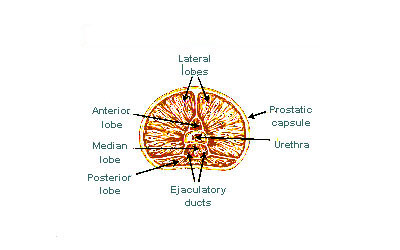Prostatectomy
Prostatectomy: Overview and Procedures[edit | edit source]
Prostatectomy refers to the surgical operation performed to either partially or completely remove the prostate gland. This procedure becomes necessary for individuals diagnosed with specific prostate-related diseases, most notably prostate cancer.
The Prostate Gland: A Brief Overview[edit | edit source]
Before discussing the prostatectomy procedure in-depth, one must understand the prostate gland's function and anatomical location.
- Location: The prostate gland, exclusive to males, lies just below the bladder and surrounds the upper part of the urethra.
- Function: The prostate plays a vital role in male reproduction by producing a fluid that nourishes and transports sperm.
Reasons for Prostatectomy[edit | edit source]
There are several medical indications for undergoing a prostatectomy, including:
- Prostate Cancer: This is the most common reason, especially when the cancer is localized and confined to the prostate.
- Benign Prostatic Hyperplasia (BPH): Surgical intervention may become necessary for severe cases where there's significant enlargement of the prostate causing distressing symptoms.
- Chronic Prostatitis: On rare occasions, if there's a long-term prostate infection that doesn't respond to other treatments.
Prostatectomy Procedures[edit | edit source]
Depending on the specific medical condition and its severity, different types of prostatectomy procedures might be recommended:
- Radical Prostatectomy: This involves complete removal of the prostate gland, along with some surrounding tissue. It's primarily used for prostate cancer cases.
- Simple or Total Prostatectomy: This procedure focuses only on removing the prostate gland without any additional tissue. It's often used for BPH.
- Laparoscopic Prostatectomy: This is a minimally invasive procedure, where surgeons make small incisions and use a camera along with specialized tools.
- Robot-assisted Laparoscopic Prostatectomy: Using robotic technology, surgeons achieve enhanced precision during the laparoscopic procedure.
Post-operative Care and Recovery[edit | edit source]
After undergoing a prostatectomy:
- Hospital Stay: A short stay, typically 1 to 2 days, might be required, depending on the procedure type and individual recovery rates.
- Activity Limitations: Heavy lifting and strenuous activities are often discouraged for 4-6 weeks post-surgery to ensure proper healing.
- Possible Side Effects: Some men might face issues like urinary incontinence or erectile dysfunction temporarily, which often improves over time with rehabilitation exercises and therapies.
Follow-ups with the urologist or surgeon are crucial to monitor recovery and detect any potential complications early.
Conclusion[edit | edit source]
The prostatectomy procedure, while intricate, serves as a lifeline for many facing severe prostate-related health issues. The evolution of medical techniques, especially minimally invasive methods, has made recovery faster and improved surgical outcomes over time.
Related Topics[edit | edit source]
Transform your life with W8MD's budget GLP1 injections from $125
W8MD offers a medical weight loss program NYC and a clinic to lose weight in Philadelphia. Our W8MD's physician supervised medical weight loss centers in NYC provides expert medical guidance, and offers telemedicine options for convenience.
Why choose W8MD?
- Comprehensive care with FDA-approved weight loss medications including:
- loss injections in NYC both generic and brand names:
- weight loss medications including Phentermine, Qsymia, Diethylpropion etc.
- Accept most insurances for visits or discounted self pay cost.
- Generic weight loss injections starting from just $125.00 for the starting dose
- In person weight loss NYC and telemedicine medical weight loss options in New York city available
- Budget GLP1 weight loss injections in NYC starting from $125.00 biweekly with insurance!
Book Your Appointment
Start your NYC weight loss journey today at our NYC medical weight loss, and Philadelphia medical weight loss Call (718)946-5500 for NY and 215 676 2334 for PA
Search WikiMD
Ad.Tired of being Overweight? Try W8MD's NYC physician weight loss.
Semaglutide (Ozempic / Wegovy and Tirzepatide (Mounjaro / Zepbound) available. Call 718 946 5500.
Advertise on WikiMD
|
WikiMD's Wellness Encyclopedia |
| Let Food Be Thy Medicine Medicine Thy Food - Hippocrates |
Translate this page: - East Asian
中文,
日本,
한국어,
South Asian
हिन्दी,
தமிழ்,
తెలుగు,
Urdu,
ಕನ್ನಡ,
Southeast Asian
Indonesian,
Vietnamese,
Thai,
မြန်မာဘာသာ,
বাংলা
European
español,
Deutsch,
français,
Greek,
português do Brasil,
polski,
română,
русский,
Nederlands,
norsk,
svenska,
suomi,
Italian
Middle Eastern & African
عربى,
Turkish,
Persian,
Hebrew,
Afrikaans,
isiZulu,
Kiswahili,
Other
Bulgarian,
Hungarian,
Czech,
Swedish,
മലയാളം,
मराठी,
ਪੰਜਾਬੀ,
ગુજરાતી,
Portuguese,
Ukrainian
Medical Disclaimer: WikiMD is not a substitute for professional medical advice. The information on WikiMD is provided as an information resource only, may be incorrect, outdated or misleading, and is not to be used or relied on for any diagnostic or treatment purposes. Please consult your health care provider before making any healthcare decisions or for guidance about a specific medical condition. WikiMD expressly disclaims responsibility, and shall have no liability, for any damages, loss, injury, or liability whatsoever suffered as a result of your reliance on the information contained in this site. By visiting this site you agree to the foregoing terms and conditions, which may from time to time be changed or supplemented by WikiMD. If you do not agree to the foregoing terms and conditions, you should not enter or use this site. See full disclaimer.
Credits:Most images are courtesy of Wikimedia commons, and templates, categories Wikipedia, licensed under CC BY SA or similar.
Contributors: Kondreddy Naveen



